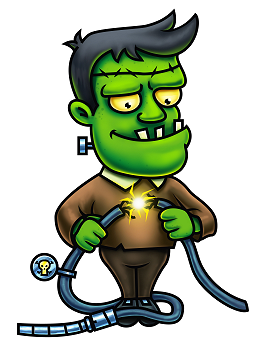Halloween History Customs And Celebrations....
Before Christianity, Britain was a Pagan country. The cycle of the seasons was very important in people's lives. Paganism is a spiritual way of life and followers of the religion look up to the blessedness of the Earth, its people and other life forms. In Pagan Britain, people saw Halloween (most Pagans refer to it by its Celtic name, Samhain (pronounced sow-en.) As marking the end of summer and the beginning of winter and as a time to honour their ancestors and seek guidance for the year to come. They had great respect for the dead. Perhaps, you feel frightened at Halloween but for modern Pagans it is a celebration. The spookiness of Halloween is just part of folk tradition.

Halloween has grown out of a joyous Pagan celebration of the turning of the seasons and the cycle of life. The turning of summer into winter was the Celtic equivalent of New Year's Eve. It was a time for looking back at who had died in the previous year. Back in these times, not all the cattle could be properly looked after over winter so many were slaughtered so that there would be enough meat to last through the cold weather. A feast was a big part of the celebration. When Britain converted to Christianity, many of the old festivals and religious sites were taken over and renamed. Christians celebrate All Saints or All Hallows day (later called Halloween) when they remember the lives of their saints.
All Hallows festival remembers the dead at the same period as the old Samhain. The idea of remembering the dead has become a scary one in today’s Halloween celebrations. For Pagans, Halloween is a major religious festival, at which they bond with their own special image of the God and Goddess. For many others, Halloween is a more light-hearted celebration. Traditional activities such as ducking for apples and pumpkin lanterns have grown from Pagan customs.
History Of The Jack O' Lantern....
The Halloween pumpkin custom probably comes from Irish folklore. Another name for the Halloween pumpkin lantern is the Jack O' Lantern. As the tale is told, a man named Jack, who was known in his town as a drunk and a prankster, tricked Satan into climbing a tree to get an apple. Jack then carved an image of a cross in the tree's trunk, trapping the devil up amongst the leaves and branches. Jack made a deal with the devil that, if he never tempted him again, he would promise to let him down from the tree.

For a time, Jack was good to his wife and children and began to go to church. But it didn't last and he soon slipped back into his old, sinful ways. According to the folk tale, after Jack died, he didn't go to Heaven because he'd behaved so badly, but he was not allowed in Hell either because he had tricked the devil. Instead, the devil gave him a single piece of coal to light his way through the darkness. The coal was placed inside a hollowed-out turnip to keep it glowing longer. The Irish used turnips as their "Jack's lanterns" originally. But when they emigrated to America, they found that there were far more pumpkins than turnips. And, so we have it - pumpkin lanterns.
On Halloween, if you look, you can still see Jack's flame burning dimly as he searches for a home.
Halloween Pumpkin History
- Pumpkins are fruits. A pumpkin is a type of squash and is a member of the gourd family (Cucurbitacae), which also includes squash, cucumbers, gherkins, and melons.
- The largest pumpkin pie ever baked was in 2005 and weighed 2,020 pounds.
- Pumpkins have been grown in North America for five thousand years. They are indigenous to the western hemisphere.
- In 1584, after French explorer Jacques Cartier explored the St. Lawrence region of North America, he reported finding "gros melons." The name was translated into English as "pompions," which has since evolved into the modern "pumpkin."
- Pumpkins are low in calories, fat, and sodium and high in fiber. They are good sources of Vitamin A, Vitamin B, potassium, protein, and iron.
- The largest pumpkin ever grown was 1,689 pounds. It was grown by Joe Jutras of North Scituate, Rhode Island.
- Pumpkin seeds should be planted between the last week of May and the middle of June. They take between 90 and 120 days to grow and are picked in October when they are bright orange in color. Their seeds can be saved to grow new pumpkins the next year.
Discover More...
Find out about Ghouls and goblins - even try out our Halloween recipe.
Celebrate the year's spookiest holiday with these essential creepy cuts.
